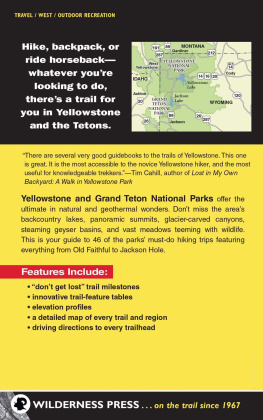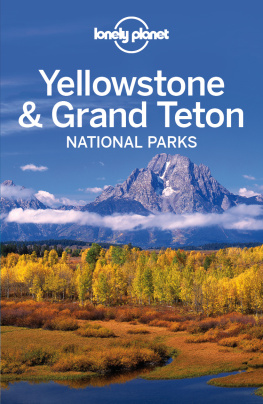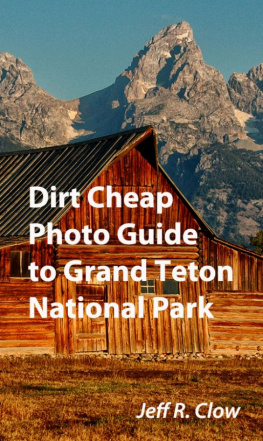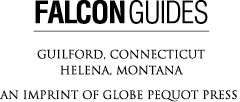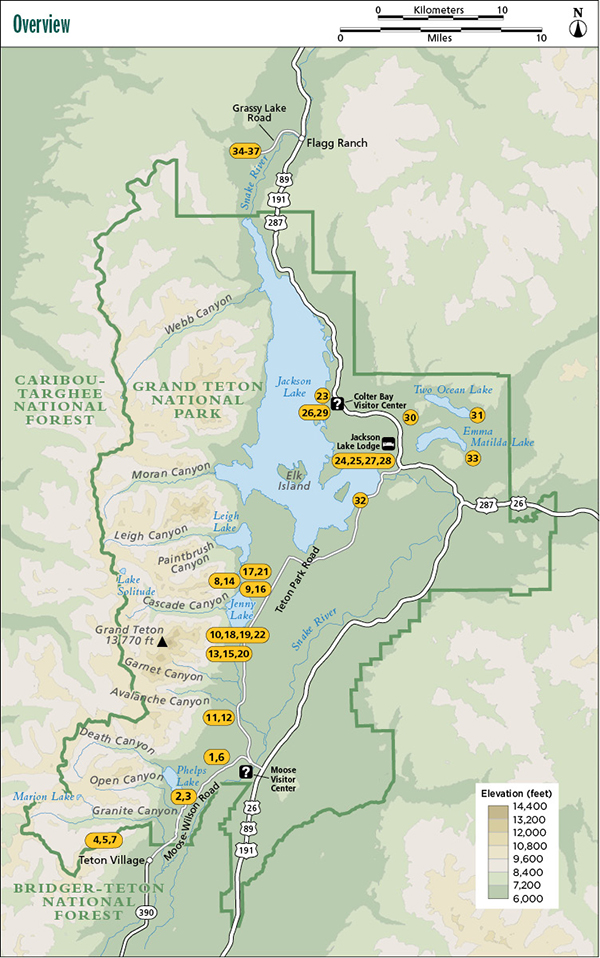Hiking Grand Teton National Park
Third Edition
Bill Schneider
HELP US KEEP THIS GUIDE UP TO DATE
Every effort has been made by the author and editors to make this guide as accurate and useful as possible. However, many things can change after a guide is publishedtrails are rerouted, regulations change, techniques evolve, facilities come under new management, and so on.
We would appreciate hearing from you concerning your experiences with this guide and how you feel it could be improved and kept up to date. While we may not be able to respond to all comments and suggestions, well take them to heart, and well also make certain to share them with the author. Please send your comments and suggestions to the following address:
Globe Pequot Press
Reader Response/Editorial Department
PO Box 480
Guilford, CT 06437
Or you may e-mail us at: editorial@GlobePequot.com
Thanks for your input, and happy trails!
2005, 2012 Morris Book Publishing, LLC
Previous editions of this book were published in 1998 by Falcon Publishing, Inc.
ALL RIGHTS RESERVED. No part of this book may be reproduced or transmitted in any form by any means, electronic or mechanical, including photocopying and recording, or by any information storage and retrieval system, except as may be expressly permitted in writing from the publisher. Requests for permission should be addressed to Globe Pequot Press, Attn: Rights and Permissions Department, PO Box 480, Guilford, CT 06437.
FalconGuides is an imprint of Globe Pequot Press.
Falcon, FalconGuides, and Outfit Your Mind are registered trademarks of Morris Book Publishing, LLC.
Project editor: David Legere
Layout: Sue Murray
All interior photographs by Bill Schneider unless otherwise noted.
Maps by Alena Pearce Morris Book Publishing, LLC
A previous edition of this book was catalogued by the Library of Congress as follows:
Library of Congress Cataloging-in-Publication Data
Schneider, Bill.
Hiking Grand Teton National Park / Bill Schneider. 2nd ed.
p. cm. (A Falcon Guide)
1. Hiking Wyoming Grand Teton National Park Guidebooks. 2. Grand Teton National Park (Wyo.) Guidebooks. I. Title. II. Series.
GV199.42.W82G7367 2005
917.87'55 dc222005040316
ISBN 978-0-7627-8768-5
The author and Globe Pequot Press assume no liability for accidents happening to, or injuries sustained by, readers who engage in the activities described in this book.
WILDERNESS is...
The FREEDOM to experience true wildness... to hear only natures music... to study the little secrets of the natural world... and to enjoy the quiet and solitude so rare in the stressful life we now live.
The CHALLENGE to learn and respect wild country... to be self-reliant... to take your time... to test your physical abilities... to courteously share the last blank spots on the map with others... and to fully enjoy your wilderness experience while leaving no trace of your passing.
The OPPORTUNITY to discover why wilderness is priceless... to see the threats to your wilderness... to decide to devote part of yourself to preserving it... and to encourage others to do the same.
Bill Schneider
The Teton Range from Schwabackers Landing. National Park Service
Contents
Acknowledgments
Most guidebooks, including this one, result from a combination of effort, not the work of one person.
I would like to thank the National Park Service (NPS) for helping me research and review this book, especially Katy Duffy, Don Burgette, Mark Mangleson, Larry Castle-Ferricks, and Sara Petsch. Also, Sharlene Milligan and Jan Lynch from the Grand Teton Natural History Association were most helpful with their review and guidance.
I also extend my gratitude to the editors, cartographers, designers, and proofreaders at Falcon Publishing and Globe Pequot Press for putting up with a difficult author.
And, of course, what would I do without Marnie, Greg, and Heidi, my Schneider family hiking companions, who kept me company on many long days and big hills while hiking all the trails of Grand Teton? Thanks all.
Introduction: Hiking Americas Most Famous Wilderness Skyline
Grand Teton National Park probably has the most famous natural skyline in the country. This prominent horizon shows up every year on millions of postcards, calendars, magazine and book covers, and television ads. But just looking at it is not enough. You need to go there and hike through the deep canyons gouged out by glaciers and over the big divides to feel the true essence of these mountains.
For outstanding mountain scenery, Grand Teton ranks, quite simply, as the best. You would have to really try hard not to have a memorable hike. As you plan your trip, here are a few things you might want to know about hiking in Grand Teton National Park.
Prime season: The best time to hike Grand Teton is August and September. Snow buries the high peaks each winter and it takes until mid-July to melt off, and sometimes until even later on high trails such as Hurricane Pass, Paintbrush Divide, and Moose Basin Divide.
Weather: It can snow any day of the year in Grand Teton, so always be prepared for it. The normal summer weather pattern (if there is such a thing) is clear mornings with thundershowers in the mid-afternoon, followed by clear, coolish evenings. This means early-morning hikers usually enjoy better weather, and they more often get their tents set up before it rains. June can frequently (but not always) be a fairly wet month in Grand Teton.
Sharing: Hikers dont have the trails of Grand Teton to themselves. They share those trails not only with a growing number of hikers and climbers but also with backcountry horse riders. If you meet a stock party on the trail, yield by moving off the trail on the downhill side and quietly let the stock animals pass.
Moose country: This is definitely moose country. In fact, its difficult to go hiking all day in Grand Teton without seeing a moose. Enjoying watching them, but stay out of the way. Moose do not yield to hikers.
Bears: Grand Teton has bears, both the common black bear and its larger, more cantankerous cousin, the grizzly. You probably wont see a grizzly, but as the bear population in the greater Yellowstone area grows, the number of grizzlies in Grand Teton continues to increase. Grizzlies are, already, more common in the northern and less frequently used sections of the park, but all of Grand Teton should be considered grizzly country. And all bearsblack and grizzlyare dangerous, so take all the standard precautions.
The canyons: Many hikes, such as Holly Lake, Cascade Canyon, and others, leave the valley floor and penetrate the Teton Range via deep, glacier-scoured canyons. The canyons serve as pathways into the high peaks. Theyre usually steep in the first few miles, then level out, and suddenly, youre surrounded by steep-walled majesty on your way up a spectacular pass or divide.



